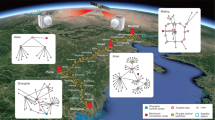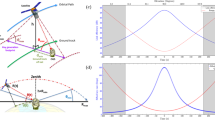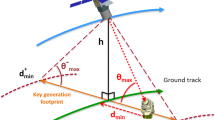Abstract
Quantum key distribution (QKD) provides the only intrinsically unconditional secure method for communication based on the principle of quantum mechanics. Compared with fibre-based demonstrations, free-space links could provide the most appealing solution for communication over much larger distances. Despite significant efforts, all realizations to date rely on stationary sites. Experimental verifications are therefore extremely crucial for applications to a typical low Earth orbit satellite. To achieve direct and full-scale verifications of our set-up, we have carried out three independent experiments with a decoy-state QKD system, and overcome all conditions. The system is operated on a moving platform (using a turntable), on a floating platform (using a hot-air balloon), and with a high-loss channel to demonstrate performances under conditions of rapid motion, attitude change, vibration, random movement of satellites, and a high-loss regime. The experiments address wide ranges of all leading parameters relevant to low Earth orbit satellites. Our results pave the way towards ground–satellite QKD and a global quantum communication network.
This is a preview of subscription content, access via your institution
Access options
Subscribe to this journal
Receive 12 print issues and online access
$209.00 per year
only $17.42 per issue
Buy this article
- Purchase on Springer Link
- Instant access to full article PDF
Prices may be subject to local taxes which are calculated during checkout




Similar content being viewed by others
References
Bennett, C. H. & Brassard, G. in Proceedings of the IEEE International Conference on Computers, Systems, and Signal Processing 175–179 (IEEE, 1984).
Gisin, N., Ribordy, G. G., Tittel, W. & Zbinden, H. Quantum cryptography. Rev. Mod. Phys. 74, 145–195 (2002).
Takesue, H. et al. Quantum key distribution over a 40-dB channel loss using superconducting single-photon detectors. Nature Photon. 1, 343–348 (2007).
Stucki, D. et al. High rate, long-distance quantum key distribution over 250 km of ultra low loss fibres. New J. Phys. 11, 075003 (2009).
Liu, Y. et al. Decoy-state quantum key distribution with polarized photons over 200 km. Opt. Express 18, 8587–8594 (2010).
Kurtsiefer, C. et al. A step towards global key distribution. Nature 419, 450 (2002).
Hughes, R. J., Nordholt, J. E., Derkacs, D. & Peterson, C. G. Practical free-space quantum key distribution over 10 km in daylight and at night. New J. Phys. 4, 43 (2002).
Peng, C-Z. et al. Experimental free-space distribution of entangled photon pairs over 13 km: towards satellite-based global quantum communication. Phys. Rev. Lett. 94, 150501 (2005).
Marcikic, I., Lamas-Linares, A. & Kurtsiefer, C. Free-space quantum key distribution with entangled photons. Appl. Phys. Lett. 89, 101122 (2006).
Schmitt-Manderbach, T. et al. Experimental demonstration of free-space decoy-state quantum key distribution over 144 km. Phys. Rev. Lett. 98, 010504 (2007).
Ursin, R. et al. Entanglement-based quantum communication over 144 km. Nature Phys. 3, 481–486 (2007).
Fedrizzi, A. et al. High-fidelity transmission of entanglement over a high-loss free-space channel. Nature Phys. 5, 389–392 (2009).
Jin, X. M. et al. Experimental free-space quantum teleportation. Nature Photon. 4, 376–381 (2010).
Scarani, V. et al. The security of practical quantum key distribution. Rev. Mod. Phys. 81, 1301–1350 (2009).
Villoresi, P. et al. Experimental verification of the feasibility of a quantum channel between space and Earth. New J. Phys. 10, 033038 (2008).
Bonato, C., Tomaello, A., Da Deppo, V., Naletto, G. & Villoresi, P. Feasibility of satellite quantum key distribution. New J. Phys. 11, 045017 (2009).
Nordholt, J. E., Hughes, R. J., Morgan, G. L., Peterson, C. G. & Wipf, C. C. Present and future free-space quantum key distribution. Proc. SPIE 4635, 116–126 (2002).
Yin, J. et al. Quantum teleportation and entanglement distribution over 100-kilometre free-space channels. Nature 488, 185–188 (2012).
Ma, X. S. et al. Quantum teleportation over 143 kilometres using active feed-forward. Nature 489, 269–273 (2012).
Rarity, J. G., Tapster, P. R., Gorman, P. M. & Knight, P. Ground to satellite secure key exchange using quantum cryptography. New J. Phys. 4, 82 (2002).
Hughes, R. J., Nordholt, J. E., McCabe, K. P., Newell, R. & Peterson, C. G. in Proceedings of Updating Quantum Cryptography and Communications 2010, 71–72 (2010).
Hwang, W. Y. Quantum key distribution with high loss: toward global secure communication. Phys. Rev. Lett. 91, 057901 (2003).
Wang, X. B. Beating the photon-number-splitting attack in practical quantum cryptography. Phys. Rev. Lett. 94, 230503 (2005).
Lo, H. K., Ma, X. F. & Chen, K. Decoy state quantum key distribution. Phys. Rev. Lett. 94, 230504 (2005).
Ma, X. F., Qi, B., Zhao, Y. & Lo, H. K. Practical decoy state for quantum key distribution. Phys. Rev. A 72, 012326 (2005).
Zhao, Y., Qi, B., Ma, X. F., Lo, H. K. & Qian, L. Experimental quantum key distribution with decoy states. Phys. Rev. Lett. 96, 070502 (2006).
Peng, C. Z. et al. Experimental long-distance decoy-state quantum key distribution based on polarization encoding. Phys. Rev. Lett. 98, 010505 (2007).
Rosenberg, D. et al. Long-distance decoy-state quantum key distribution in optical fiber. Phys. Rev. Lett. 98, 010503 (2007).
Wang, X. B. Decoy-state protocol for quantum cryptography with four different intensities of coherent light. Phys. Rev. A 72, 012322 (2005).
Gottesman, D., Lo, H. K., Lütkenhaus, N. & Preskill, J. Quantum Inf. Comput. 4, 325–360 (2004).
Nauerth, S. et al. Air to ground quantum key distribution, abstract, Conference on Quantum Cryptography (2012); available at http://2012.qcrypt.net/docs/extended-abstracts/qcrypt2012_submission_12.pdf
Acknowledgements
The authors thank the staff of the Qinghai Lake National Natural Reserve Utilization Administration Bureau, especially Y-B. He and Z. Xing, for their support during the experiment. This work was supported by the Chinese Academy of Sciences, the National Natural Science Foundation of China, and the National Fundamental Research Program (grant no. 2011CB921300).
Author information
Authors and Affiliations
Contributions
C-Z.P and J-W.P. conceived the idea for the experiments. J-Y.W., C-Z.P. and J-W.P. designed the experiments. B.Y., S-K.L., Q.S., X-F.H., J-C.W., H.L., J.Y., J-G.R., G-S.P. and C-Z.P. designed the QKD devices. J-Y.W., S-K.L., L.Z., J-C.W., S-J.Y., H.J., Y-H.H., Y-M.H., B.Q., J-J.J. and C-Z.P. designed the ATP devices. S-K.L., L.Z., X-F.H., Y-L.T., B.Z. and W-Y.L. designed the software. All authors performed the experiments. B.Y., W-Y.L., K.C., Y-A.C., C-Z.P. and J-W.P. analysed the data. B.Y., K.C., Y-A.C., C-Z.P. and J-W.P. wrote the paper. J-W.P. supervised the entire project.
Corresponding authors
Ethics declarations
Competing interests
The authors declare no competing financial interests.
Supplementary information
Supplementary information
Supplementary information (PDF 795 kb)
Rights and permissions
About this article
Cite this article
Wang, JY., Yang, B., Liao, SK. et al. Direct and full-scale experimental verifications towards ground–satellite quantum key distribution. Nature Photon 7, 387–393 (2013). https://doi.org/10.1038/nphoton.2013.89
Received:
Accepted:
Published:
Issue Date:
DOI: https://doi.org/10.1038/nphoton.2013.89
This article is cited by
-
Polarization bases compensation towards advantages in satellite-based QKD without active feedback
Communications Physics (2023)
-
Quantum NETwork: from theory to practice
Science China Information Sciences (2023)
-
Entanglement of Hybrid State in Noninertial Frame
International Journal of Theoretical Physics (2023)
-
N-partite coherence of bosonic fields in the background of a Schwarzschild black hole
Quantum Information Processing (2022)
-
Strategies for achieving high key rates in satellite-based QKD
npj Quantum Information (2021)



